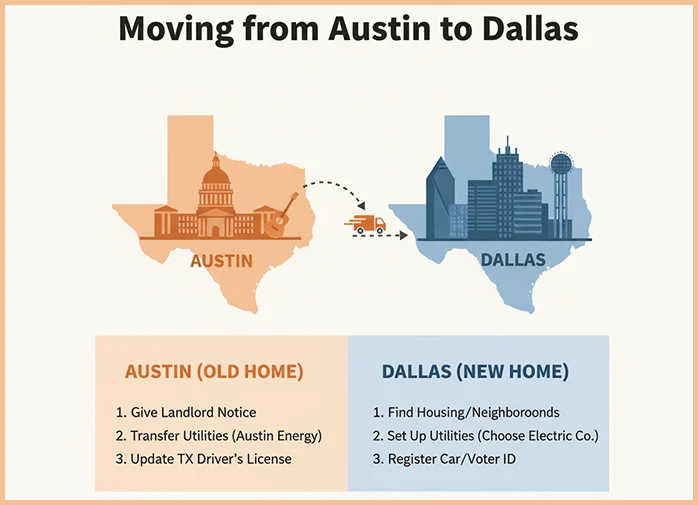To help maintain VanlinesMove.com and keep our resources free for users, we receive compensation from service providers featured on our site. This compensation comes from two primary sources: paid placements, which affect the order and visibility of providers’ offers, and affiliate links that may generate commissions when clicked. Not all providers in the market are included.
While this compensation influences placement, it does not impact our editorial content or recommendations. The information provided is for general informational purposes only and should not be taken as legal, financial, or professional advice. We recommend conducting thorough research and consulting experts before making any relocation decisions. For more details, please refer to our Terms of Use and Privacy Policy.

Moving to Saint Paul in 2025?
Complete Moving Guide
This is a complete guide for Moving to Saint Paul.
Get all the information you need to know about moving to Saint Paul.

Planning to move to Saint Paul?
Saint Paul, Minnesota is a city with distinct features. Saint Paul is a twin city with Minneapolis and each has unique characteristics. Saint Paul is more traditional while Minneapolis is more modern and business oriented. The city experiences extreme seasonal variations. The city is known for its historic neighborhoods, strong sense of community, and cultural institutions. It is home to several renowned colleges and universities including Macalester College and University of St. Thomas. The city has an extensive system of parks that offer plenty of outdoor recreational fun opportunities. Public transport is available in the city however, having a car is a great option, especially during the winter. These pointers can help you learn about the city, but our moving guide can help you know about the statistics and relevant details about different aspects of the city-
 Quick Facts About Saint Paul
Quick Facts About Saint Paul  Top Reasons To Move To Saint Paul
Top Reasons To Move To Saint Paul  Pros And Cons Of Living In Saint Paul
Pros And Cons Of Living In Saint Paul  Best Neighborhoods In Saint Paul
Best Neighborhoods In Saint Paul  Cost Of Living In Saint Paul
Cost Of Living In Saint Paul  Job Market In Saint Paul
Job Market In Saint Paul  Major industries in Saint Paul
Major industries in Saint Paul  Education System in Saint Paul
Education System in Saint Paul  Transportation And Navigation In Saint Paul
Transportation And Navigation In Saint Paul  Things To Do In Saint Paul
Things To Do In Saint Paul  Taxes In Saint Paul
Taxes In Saint Paul  Insurance Required In Saint Paul
Insurance Required In Saint Paul
Quick Facts of Saint Paul
Some facts about Saint Paul that will amaze you-
- Saint Paul was originally known as “Pig’s Eye” and was named after Pierre "Pig's Eye" Parrant, a one-eyed fur trader.
- The city boasts more Mississippi Riverfront (26 miles) than any other city along the river.
- The world's second-largest self-supported marble dome is the feature of the Minnesota State Capitol.
- The city has a notorious gangster past with figures like John Dillinger.
- F. Scott Fitzgerald was born in Saint Paul.
- Scotch tape was invented in Saint Paul.
- The Saint Paul Winter Carnival is a long-standing tradition.
- The city hosts the largest Hmong American sports festival in the country.
Top reasons to move to Saint Paul
People move from state to state, city to city, to find something better in their life. There are various reasons to move to a new city like Saint Paul-

- Cost of living- The cost of living in Saint Paul is relatively affordable, and housing is the major factor contributing to the lower cost of living.
- Education- The education system in Saint Paul is strong with quality public and private schools. There are several higher education institutions in the city.
- Job Market- The city has a diverse and strong economy with job opportunities in several sectors, including healthcare, finance, and technology.
- Community- The city is known for its friendly and welcoming residents and a strong sense of community.
- History and culture- Saint Paul has a beautiful history and well-preserved neighborhoods. The city boasts vibrant arts and culture vibes with theatres, museums, and more.
- Outdoor recreation- The city has an extensive park system with plenty of outdoor opportunities. The Mississippi River also offers recreational opportunities.
Pros & Cons of Living in Saint Paul
The best way to prepare for a move is by learning about the pros and cons of life in a new city. Here are the pros and cons of living in Saint Paul-

| Pros of Living in Saint Paul | Cons of Living in Saint Paul |
|---|---|
| The city has friendly and welcoming residents & strong sense of community | The city is known for its heavy snowfall and this can be challenging |
| Cost of living in Saint Paul is relatively affordable | Nightlife in the city is generally considered quiet |
| There are plenty of outdoor recreational opportunities | Property taxes are relatively high in Saint Paul |
| The job market of the city is robust and diverse | Some areas of the city are at risk of flooding |
| The city has well-preserved neighborhoods and historic architecture | Some of the infrastructure in the city are aging and can cause inconvenience |
| Public transportation in the city is decent | — |
Best Neighborhoods in the Saint Paul
When you move to a new city, the first thing to connect with the location is the neighborhood. A safe neighborhood and caring neighbors can help you with the transition. Before you move to Saint Paul, learn about its neighborhoods so that you can pick the one you find better-

- Macalester-Groveland- This is a lively neighborhood with a mix of families, young professionals, and students. This location is home to Macalester College and the University of St. Thomas. It offers an academic atmosphere and features charming homes.
- Highland Park- This neighborhood offers residential and commercial spaces. It is known for its beautiful parks, strong community, and excellent schools. The crime rates are lower in this location.
- Summit Hill- This is an elegant and historic neighborhood with Victorian-era mansions. There are beautiful tree-lined streets and a prestigious atmosphere. It has upscale shops and restaurants.
- Saint Anthony Park- This is a historic neighborhood with strong sense of community and small-town feel. The neighborhood is home to the University of Minnesota’s Saint Paul campus.
- Como Park- This location is centered around the beautiful Como Lake and Como Park Zoo & Conservatory. It offers abundant recreational opportunities and it is a family-friendly area.
Cost of living in Saint Paul
The cost of living in a new city can affect your moving budget. So, before you plan your finances, explore the cost of living in the new city. The cost of living in Saint Paul is generally considered affordable, and its overall cost of living is lower than the national average. All the amenities, including housing, groceries, utilities, and more, are available at affordable rates. Here is the breakdown for the cost of living in Saint Paul-

| Category | Saint Paul (in USD) |
|---|---|
| Rent (1-bedroom apartment) | $1,100 - $2,100 |
| Median Home Price | $280,000 - $400,000 |
| Groceries (Monthly) | $600 - $1,300 |
| Utilities (Monthly) | $170 - $800 |
| Transportation (Monthly) | $400 - $900 |
| Healthcare (Monthly) | $140 - $450 |
Housing Market in Saint Paul
The housing market of Saint Paul is currently experiencing fluctuations. It is generally considered a seller’s market and recently the home prices have shown rising. The median home price for a house in Saint Paul is around $280,000 - $400,000.
Average rental cost in Saint Paul
The average rental cost for a house in Saint Paul ranges from $1,100 to $2,100.
Saint Paul job market
In Saint Paul, the job market is generally considered strong and boasts a lower unemployment rate. The economy of the region is highly diverse with the presence of several significant factors. It has shown a significant growth in the tech industry and home to several Fortune 500 company headquarters.
Top Career Options in Saint Paul
Explore the career opportunities in Saint Paul and their related statistics-
| Job Title | Average Salary | Entry-Level Salary |
|---|---|---|
| Healthcare | $70,000 - $160,000+ | $40,000 - $60,000 |
| Technology | $70,000 - $150,000+ | $50,000 - $70,000 |
| Business/Finance | $60,000 - $130,000+ | $40,000 - $60,000 |
| Education | $45,000 - $90,000+ | $35,000 - $50,000 |
| Manufacturing | $50,000 - $120,000+ | $35,000 - $50,000 |
Median Salary in Saint Paul
The median salary of a household in Saint Paul is around $73,055 a year.
Transportation And Navigation In Saint Paul
Saint Paul, as a part of the Twin Cities, has a reasonably well-developed transportation system.
Public Transportation- Metro Transit if the primary public transportation provider that offers bus and light rail service. There is METRO Green Line light rail that connect Saint Paul to Minneapolis. Other option is Amtrak which is a passenger rail service to regional and national destination. The city has designated bike lanes and pedestrians to make commute efficient. There are options for car-sharing and ride-sharing. Navigation- The city is served by major interstate highways that facilitate travel easily and efficiently. It is easy to navigate the city with the use of GPS-based apps including Google Maps and Metro Transit App.
Major industries in Saint Paul
The city is home to several major industries, including-
- Healthcare and Social Assistance
- Educational services
- Finance and Insurance
- Technology and Innovation
- Manufacturing
- Retail Trade
- Public Administration
Education System in Saint Paul
After moving to a new city, one of the major challenges is to find a good school or college for your children. So, to avoid the hassle, explore some schools or colleges in your destination city before you move there. Here, we have listed some good schools, colleges, and universities in Saint Paul-

| Elementary Schools in Saint Paul |
|---|
| Jie Ming Mandarin Immersion Academy |
| Randolph Heights Elementary School |
| Horace Mann School |
| Capitol Hill Gifted & Talented Magnet |
| Riverview Spanish/English Dual Immersion Program |
| Middle Schools in Saint Paul |
|---|
| E-STEM Middle School |
| Capitol Hill Gifted & Talented Magnet |
| Open World Learning Secondary School |
| Farnsworth Aerospace 5-8 Campus |
| Highland Park Middle School |
| High Schools in Saint Paul |
|---|
| Central Senior High School |
| Highland Park Senior High School |
| Johnson Senior High School |
| Como Park Senior High School |
| Open World Learning Secondary School |
| Colleges and Universities in Saint Paul |
|---|
| University of St. Thomas |
| Macalester College |
| Hamline University |
| Concordia University, St. Paul |
| St. Catherine University |
Best things to do in Saint Paul
After moving into the city, you can explore it to connect with the location and locals.

Explore cultural and historical attractions across the city-
- Minnesota History Center
- Minnesota State Capitol
- Science Museum of Minnesota
- Landmark Center
- James J. Hill House
- Catch a Broadway show at Ordway Center for the Performing Arts.
- CHS Field is home to the Saint Paul Saints, a minor league baseball team.
- Visit Can Can Wonderland to enjoy mini-golf, creative cocktails, and vintage arcade games.
Saint Paul has a designated park system, so enjoy nature and greenery at
- Como Park Zoo & Conservatory
- Harriet Island Park
- Mississippi Riverfront
- Catch a Broadway show at Ordway Center for the Performing Arts.
- CHS Field is home to the Saint Paul Saints, a minor league baseball team.
- Visit Can Can Wonderland to enjoy mini-golf, creative cocktails, and vintage arcade games.
Catch a Broadway show at Ordway Center for the Performing Arts.
CHS Field is home to the Saint Paul Saints, a minor league baseball team.
Visit Can Can Wonderland to enjoy mini-golf, creative cocktails, and vintage arcade games.
Taxes in Saint Paul
All the residents of Saint Paul has to pay taxes applied on good and services. Here is the breakdown for the taxes in Saint Paul-

Income Tax- Minnesota has a graduated system of income tax which means the tax rate increases with the increase in income.
Sales Tax- Minnesota has a sales tax rate of 6.88% and Saint Paul has a local sales tax of 1.5%. So, a total of 9.88% sales tax is paid by the residents.
Property Tax- Property tax in Saint Paul vary depending on the location and the value of the property.
Hotel/Motel Lodging Tax- There is a lodging tax on hotels and motels within the city limits.
Type of insurance required in Saint Paul
When you move to a new state or city, you have to buy different insurance, some of which are mandated by state law.

Auto Insurance- Minnesota state law mandates that all vehicle owners must carry minimum liability coverage. Here is the breakdown of the minimum liability coverage-
- Bodily Injury Liability: $30,000 per person
- Bodily Injury Liability: $60,000 per accident
- Property Damage Liability: $10,000 per accident
Workers’ Compensation- All employers in Minnesota generally required to provide workers’ compensation insurance to cover employees who suffer work-related injuries.
Homeowners or Renters Insurance- This is not legally required, but having homeowner and renters’ insurance is highly recommended. This will protect your property and belongings from damage or loss caused due to theft, fire, or other covered events.
Health Insurance- Having health insurance is crucial as it covers medical expenses.
Life Insurance- This insurance provides financial support to your family in the event of your death.
Disability Insurance- This insurance help replace income if a person become unable to work due to illness or injury.
Disclaimer: The information provided in this guide is for informational purposes only and should not be construed as legal, financial, or professional advice. It is recommended to conduct thorough research and consult relevant experts before making any decisions related to relocation.
State Moving Guides
- Alabama
- Arizona
- Arkansas
- California
- Colorado
- Connecticut
- Delaware
- Florida
- Georgia
- Hawaii
- Idaho
- Illinois
- Indiana
- Iowa
- Kansas
- Kentucky
- Louisiana
- Maine
- Maryland
- Massachusetts
- Michigan
- Minnesota
- Mississippi
- Missouri
- Montana
- Nebraska
- Nevada
- New Hampshire
- New Jersey
- New Mexico
- New York
- North Carolina
- North Dakota
- Ohio
- Oklahoma
- Oregon
- Pennsylvania
- Rhode Island
- South Carolina
- South Dakota
- Tennessee
- Texas
- Utah
- Vermont
- Virginia
- Washington DC
- West Virginia
- Wisconsin
- Wyoming
- Washington D.C.
Movers By State
- Alabama, AL
- Alaska, AK
- Arizona, AZ
- Arkansas, AR
- California, CA
- Colorado, CO
- Connecticut, CT
- Delaware, DE
- Florida, FL
- Georgia, GA
- Hawaii, HI
- Idaho, ID
- Illinois, IL
- Indiana, IN
- Iowa, IA
- Kansas, KS
- Kentucky, KY
- Louisiana, LA
- Maine, ME
- Maryland, MD
- Massachusetts, MA
- Michigan, MI
- Minnesota, MN
- Mississippi, MS
- Missouri, MO
- Montana, MT
- Nebraska, NE
- Nevada, NV
- New Hampshire, NH
- New Jersey, NJ
- New Mexico, NM
- New York, NY
- North Carolina, NC
- North Dakota, ND
- Ohio, OH
- Oklahoma, OK
- Oregon, OR
- Pennsylvania, PA
- Rhode Island, RI
- South Carolina, SC
- South Dakota, SD
- Tennessee, TN
- Texas, TX
- Utah, UT
- Vermont, VT
- Virginia, VA
- Washington, WA
- Washington DC, DC
- West Virginia, WV
- Wisconsin, WI
- Wyoming, WY
Cities Moving Guides
- Los Angeles
- Atlanta
- San Francisco
- New York
- Dallas
- Houston
- Charlotte
- Chicago
- Miami
- Orlando
- Austin
- San Diego
- San Jose
- Greenville
- Charlottesville
- St. Augustine
- Chattanooga
- Billings
- Wilmington
- Fort Myers
- Decatur
- Burlington
- Cheyenne
- Asheville
- Boulder
- Little Rock
- Cary
- Conroe
- Baton Rouge
- Port St. Lucie
- Tampa
- Naples
- Fayetteville
- Ocala
- York
- Brownsville
- Denver
- Charleston
- Phoenix
- Tallahassee
- Killeen
- Myrtle Beach
- Lakeland
- Daytona Beach
- Oklahoma City
- Buffalo
- Rochester
- San Antonio
- Spring
- Reno
- Olympia
- Eugene
- Saint Louis
- Hartford
- Henderson
- Winterville
- Las Vegas
- Raleigh
- Sarasota
- Portland
- Overland Park
- The Villages
- Wheelersburg
- Honolulu
- Richmond
- Sioux Falls
- Jacksonville
- Washington D.C
- Montgomery
- South Bend
- Hickory
- Des Moines
- Topeka
- Randallstown
- Adrian
- Webster
- Cleveland
- Albany
- Nampa
- Anaheim
- Lansdowne
- Detroit
- Saint Paul
- Arlington
- Hallstead
- Sheboygan
- Littleton
- Gilroy
- Carson
- Saint Helena
- Harper
our quick Services
-
Local Movers
Move within the state with local moving company.
-
Long Distance Movers
Find your Out of State moving partner for relaxed long-distance moving.
-
Commercial Movers
Let professionals handle your corporate move at the best prices.
-
Furniture Movers
Move your antiques and furniture with qualified movers.
-
Last-Minute Movers
No time to pack? Hire last-minute moving partners with Van Lines Move.
-
Car Transportation
Get your car anywhere you want in the USA with a licensed Car Transportation company.
-
Junk Removal
Remove junk from your home, office, or commercial site. Hire experts.
-
Heavy Equipment
Heavy Equipment moving solutions customized as per your need across the USA.

 Local Movers
Local Movers Last-Minute Movers
Last-Minute Movers Junk Removal
Junk Removal Long Distance Movers
Long Distance Movers Piano Movers
Piano Movers Heavy Equipment
Heavy Equipment Commercial Movers
Commercial Movers Moving Container
Moving Container Car Transportation
Car Transportation Furniture Movers
Furniture Movers Truck Rental
Truck Rental Moving Cost Calculator
Moving Cost Calculator Moving Planner
Moving Planner Packing Calculator
Packing Calculator Moving Checklist
Moving Checklist Moving Insurance
Moving Insurance FAQ
FAQ Contact Us
Contact Us Moving Loan
Moving Loan About Us
About Us

.webp)













